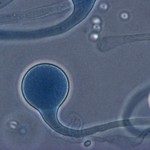Lien vers Pubmed [PMID] – 30816963
Lien DOI – 10.1093/mmy/myy081
Med. Mycol. 2019 Apr; 57(Supplement_2): S94-S103
Invasive aspergillosis (IA) incidence is increasing in several countries like France, and numerous cases are indeed missed and still only diagnosed at autopsy as evidenced by recently published data. Such missed diagnoses are obviously encountered when appropriate diagnostic tools are not available especially in low resource areas or when biologists have not been trained enough in medical mycology (i.e., microscopic examination and culture in most of those areas). Besides logistical issues, which are indeed critical, IA may not be recognized because clinicians failed to consider that risk factors are evolving with the IA burden now observed among patients with chronic lymphoid malignancies or receiving new biotherapies, with diabetes mellitus or liver cirrhosis and/or acute alcoholic hepatitis, with patients from the intensive care unit (ICU) and among patients with some predisposing primary immune deficiencies now reaching the adult’s age. This is also the case for human immunodeficiency virus (HIV)-infected patients who failed to meet the classical definitions of IA. From the radiology perspective, new entities of IA have also emerged which absolutely need to be recognized especially bronchial-based-IA among allogeneic stem cell transplant recipients. Finally, from the laboratory side, contribution and limits of indirect blood biomarkers should be integrated to the clinical life in order not to miss IA cases. To conclude, several diagnostic tools should be combined and a constant dialog between laboratory and clinics is crucial to appropriately diagnose IA.




